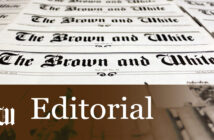A Little Life is the saddest book I’ve ever read, but it’s also one of the best.
The novel is heavy — both figuratively and literally — as the tale of four friends navigating neglect, abuse, trauma, violence, addiction and loss unfolds across more than 800 pages.
A devastating look into the darkest depths of human experience, albeit extremely disturbing, made this book nearly impossible to put down once I’d picked it up.
Set against the backdrop of a timeless New York City, Hanya Yanagihara weaves a riveting tale of the fictional yet all-too-realistic Willem Ragnarsson, Malcolm Irvine, Jean-Baptiste (JB) Marion and Jude St. Francis. Their bond, established at a prestigious New England college, is both their greatest solace and their most painful burden.
The novel opens with descriptions of the diverse group: handsome and lovable Willem, son of now-estranged ranchers in Wyoming, working as a server while aspiring to be an actor; passionate yet reserved Malcolm, born to a wealthy Upper East Side biracial couple who have good intentions and high expectations for their son; the seemingly confident JB, son of Haitian immigrants who is employed as a receptionist while awaiting his big break as an artist; and Jude St. Francis, the mysterious mathematician turned successful lawyer, whose origins and background are largely unknown — to friends and readers alike — yet who quickly becomes the focal point of the novel.
Yanagihara expertly weaves the ways their four lives intertwine over the years and the fluctuations in their friendships with one another to create an honest look at the maturation — or lack thereof — of individuals and how experiences in one’s personal life profoundly impact their connections with others.
Other recurring characters help develop the story and uncover disturbing truths. Harry and his wife Julia, whom I found to be underrated and overshadowed, and Andy play pivotal roles in Jude’s post-college life, and their relationships with Jude position them within the lives of the rest of the foursome, too.
Yanagihara often deposits Jude in the center of the story, and often he reflects upon his favorite mathematical axiom. Though I’m not a math person, I have a feeling the axiom of equality, which states that “x always equals x,” will stick with me for a while.
As the truth about Jude’s past is gradually revealed, he applies the axiom to himself. Believing that he was born for abuse and humiliation, readers begin to uncover the inner strife the successful litigator hides under his freshly ironed suit and steady demeanor.
With each page, I felt a real connection to Jude and the rest of the characters, who are as different from one another as they are fascinating. Though Willem is depicted as the should-be fan favorite, Malcolm stood out to me as the most loyal. With subtle yet immeasurable posits of thoughtfulness and genuine care, he never fails to put the interests of his friends — and other people in general — above that of his own.
And while I’m quick to pick a favorite of the foursome, each had something I rarely find in a fictional novel: authenticity. Not once throughout the story did the author allude to any of them, or any of the other characters, as being anything but imperfect. This made the novel more distressing, yet so much more intriguing.
Each of them holds onto the delicate lifeline of friendship amid hardship. Throughout the story, each time one of the four finally gets up, another falls — usually even further.
Jude’s struggles, and the way he keeps a lifetime of physical and mental scars hidden from those closest to him for so long, gave me a newfound compassion for others, too. It’s never been so clear to me that everyone goes through their own battles, and as cheesy as it sounds, I’ll never again judge a book by its cover.
My one complaint is that I felt Yanagihara discussed the backstories and hardships of the characters other than Jude a bit too briefly. Even without explaining each of their hardships to the extent in which she described Jude’s physical and mental tribulation, though, I wouldn’t wish what the characters witnessed and experienced on anyone.
Though mentioned casually throughout the book and occasionally honed in on in minor riffs between characters, sexuality and race are not major issues in the story. Among each other, these things didn’t matter; what mattered were the relationships they held, the experiences they had and the people they became.
Another thing mentioned even less in the book — apart from that of the characters — is history. Yanagihara makes no references to notable historical events, nor does she give many hints as to what time period the story is supposed to take place in.
Yanagihara does, however, mention social class and money throughout the story, and luxury often serves as a stark contrast to turmoil throughout the novel. She describes lavish weekends on the Cape, extravagant trips to Europe and Asia, and the purchasing of numerous vacation homes intermittently throughout the novel. She also deposits more subtle references to designer brands, costly renovations and classy events the foursome attends.
That is when she’s not describing in (almost too much) detail the inner demons or the most recent tragedy of one of the characters.
Wrought with themes of friendship, pain, loss, grief and love, the story of these four friends felt so real to me.
Though I could pick out hundreds of beautifully written sentences, one of my favorite quotes from the book helps sum up the still-growing appreciation I have for the relationships in my own life: “Wasn’t friendship its own miracle, the finding of another person who made the entire lonely world seem somehow less lonely?”
Through their good days and bad days, the flawless writing by Yanagihara made each character seem so human.
The verisimilitude of A Little Life is shocking, and though I give this book 5/5 stars, I wouldn’t recommend it to anyone without simultaneously recommending you read some trigger warnings in advance. If after doing so you feel up to reading it, prepare yourself for 800 pages of nail-biting, gasping, crying and likely a lot of self-reflection.






Comment policy
Comments posted to The Brown and White website are reviewed by a moderator before being approved. Incendiary speech or harassing language, including comments targeted at individuals, may be deemed unacceptable and not published. Spam and other soliciting will also be declined.
The Brown and White also reserves the right to not publish entirely anonymous comments.